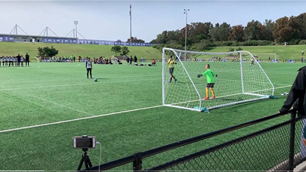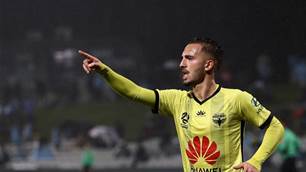EXCLUSIVE: The story of Sydney NSL club Parramatta Power is a sobering reminder of the task ahead for any new A-League franchise, particularly in the west of the city.
Almost ten years to the day - October 1, 1999 - the much hyped Parramatta Power kicked off the NSL season against west Sydney rivals Marconi. Power was a new NSL club, one targeting the mainstream western Sydney sports fans and the families of thousands of juniors playing in the area.
After the stunning success of so-called mainstream clubs Northern Spirit, based in Sydney's north shore, and Perth Glory, there were high hopes that the west of Sydney could match, or even eclipse their success.
Then there were the so-called "migrant" clubs, namely Sydney United and Marconi, who'd contributed so much to the development of the game in the west. Power was an intriguing move for an NSL beginning to sense the mood of change.
Parra Power were ahead of their time. Fully professional in almost every aspect, its infrastructure and financial backing would make it a strong candidate for an A-League expansion licence even now.
With unrivalled financial muscle, Power continually attracted a who's who roster of stars. In 1999, Mile Sterjovski, Jacob Burns and Joel Griffiths were part of a star-studded squad assembled by David Mitchell and Lawrie McKinna.
And virtually their entire squad for the 2004 NSL grand final against Perth Glory went on to succeed in the A-League.
Power's line up that day was: Clint Bolton, Alvin Ceccoli, Simon Colosimo, Michael Beauchamp, Travis Dodd, Andre Gumprecht, Ante Milicic (Fernando Rech 68), Paul O'Grady, Sasho Petrovski, Ahmad Elrich, Peter Zorbas (Matthew Thompson 97).
But despite some on-field success later in its five year history, the club tanked badly. Crowds were pitifully small at the excellent home ground Parramatta stadium. Only in the local derbies did the atmosphere lift and crowd numbers eclipse 2-3000.
The club's major sponsor Power Credit Union ended its four year $1.2m sponsorship (a large amount at that time in the NSL) in 2003 and the NSL folded a year later.
What can be learnt from this disaster? It's a question particularly relevant given the apparent arrival of a new A-League franchise in the west of Sydney.
One man intimately involved with Parramattta Power was Vince Del Zio. The avowed football fan was CEO of Power Credit Union, an organisation turning over $160m and based in Parramatta. They saw sponsorship of a new and exciting NSL club as important in raising the company's profile and a potentially smart business move.
Del Zio told au.fourfourtwo.com that he became deeply frustrated with the way the club was run. And he says anyone launching an A-League franchise in the west needs to learn from the Parramatta Power failure. "They had the strongest squad in Australia. And if they had a proper administration and CEO, the club would've made money," he said.
"It was a great idea, a fantastic opportunity; unfortunately wrong people in charge. Egos got in the way.
"They didn't do their homework or anticipated how much work is involved in running a club, especially an NSL squad."
The club was administered by people involved with Parramatta Leagues and Parramatta Eels NRL club. It's well known that coach David Mitchell and his assistant Lawrie McKinna became frustrated with the inability to understand the global view of football, particularly earning a revenue stream from the sale of Aussie players raised by Parramatta's excellent youth system (which produced the likes of Ahmad Elrich and Brett Holman) and first team.
The coaching duo left after three frustrating seasons to be replaced by Nick Theodorakopoulos. The former NSL grand final winning coach was given an open cheque book (there was no salary cap back then), and bought together a superb list which played beautiful football.
Unfortunately, the club was unable to grasp this fact while crowds continued to stall despite Power making the last ever NSL grand final in 2004 and finishing in the top three for two seasons running (2002/3 and 2003/4).
Perhaps the football Gods were trying to tell Parramatta Power something that opening night ten years ago - the heavens opened threatening to force a cancellation.
The game went ahead but all the hard work marketing the club's opening clash was washed away. A hardy 8,000 fans braved the torrent at Parramatta stadium and the fans never came back.
Five years later, Power played the last ever NSL match, the 2004 grand final against Perth Glory. Again, a drenched stadium saw the home side edged out by a Nick Mrdja strike.
What happened in-between was a timely reminder of how hard it is to market a club in the west of Sydney. It's not just about a winning team or a team of stars. The right people in charge for the right reasons is arguably more important.
And the organisation cannot assume that just because the west is overflowing with potential A-League fans, they'll simply turn up in droves.
The marketing, club culture and awareness of football's uniqueness has to be right from the get-go. Power got it wrong from day one and suffered the consequences.
Del Zio now works as a bank manager at Westpac. He watches the A-League and is an interested observer of the bidding process for a second A-League club in Sydney. In fact, his business and football background (his son Stefan is a former U/17 international) makes him ideal for any board of a new western Sydney club.
He rues the fact that such an opportunity was butchered at Parramatta. Had things turned out differently, he could've been involved with Parramatta Power as an A-League franchise - just as NSL clubs Adelaide United and Perth Glory were upgraded to the new A-League in 2005.
"Any A-League club needs to have the right management team with a good football understanding," he stresses.
"We could've still had a Parramatta Power today, representing the west of Sydney, well and truly established, without having to reinvent the wheel.
"They could've been part of the new A-League. Now we need to start all over again."
Related Articles

Fresh talent flock to ambitious A-League outfit's pro pathway

Why A-League 20/21 is crucial for Olyroos’ medal hopes













